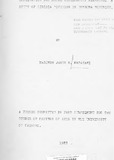| dc.contributor.author | Masinde, Jamin R. Masasa bi | |
| dc.date.accessioned | 2013-04-19T08:30:11Z | |
| dc.date.issued | 1987 | |
| dc.identifier.citation | M.A Thesis 1987 | en |
| dc.identifier.uri | http://erepository.uonbi.ac.ke:8080/xmlui/handle/123456789/16389 | |
| dc.description | Master of Arts Thesis | en |
| dc.description.abstract | It is the central thesis of this study that social and economic factors are the major determinants of the performance of women groups in rural Kenya. Data from Sirisia Division, a rural area in Bungoma District in Western Province is used to determine whether the assertion is true.
Therefore the study investigates the extent to which socio-economic factors are related to performance as indicated by the major independent variables. The study also holds that such factors determine the degree to which women are committed in processes accruing to participation in groups. The major aim of the study is therefore to explain why some groups in rural areas perform better in income generation than others in the same environment. Performance in the study is measured by earning to members, changes in the women's standards of living; decision making ability,objective and project achievement. A major justification of this study lies in the observation in recent research studies that women in women's groups generally gain and therefore greatly improve their standards of living in their communities and
families. There is also a recognition that rural development is impossible '.·,ithout e;reater contribution of women 10 constituted the majority of the inhabitants in the rural sector.
This is thus a critical area of inquiry to enhance a clear understanding of conceptions about
rural women groups. The area of study was Sirisia Division in Bungoma District. The simple random sampling technique was employed in the selection of the respondents. The individual women are the unit· of study while women members and leaders of groups were the respondents. The interview schedule is the major data gathering toOlused in the study. On the
other hand the chi-square (X2), the gamma test and percentages are the major tools for data analysis. The major research findings from the field data show that socio-economic factors determine the performance of womengroups. The analysis shows that leadership qualities of women are important determinants of women groups, The study also indicated that ordinary members should not be descriminated when offering training courses. The study confirmed that the level of education and training have a significant influence on group performance. There should be an information system aimed at improving their capacity to venture in productive activities. The findings further show that the size of the groups and the socio-economic status of the 'No men have a significant impact on the performance of women groups. These findings therefore confirm the thesis advanced by the study. However the family structures of the women and motivation of the women to join groups did not have a significant relationship with the performance of the groups.
In conclusion the study underlined the fact that women groups generally play an important role in
rural development. This is well recognised in the type of projects that the various groups engage in. The analysis further concludes that in spite of the significant role the groups play in rural development, the benefits that accrue to the members are not obvious. More often than not the women members do not benefit from the groups | en |
| dc.description.sponsorship | University of Nairobi | en |
| dc.language.iso | en | en |
| dc.title | Determinants of women groups performince and their implication for rural development planning: A study of Sirisia division in Bungoma district | en |
| dc.type | Thesis | en |
| local.publisher | Faculty of Arts, University of Nairobi | en |

